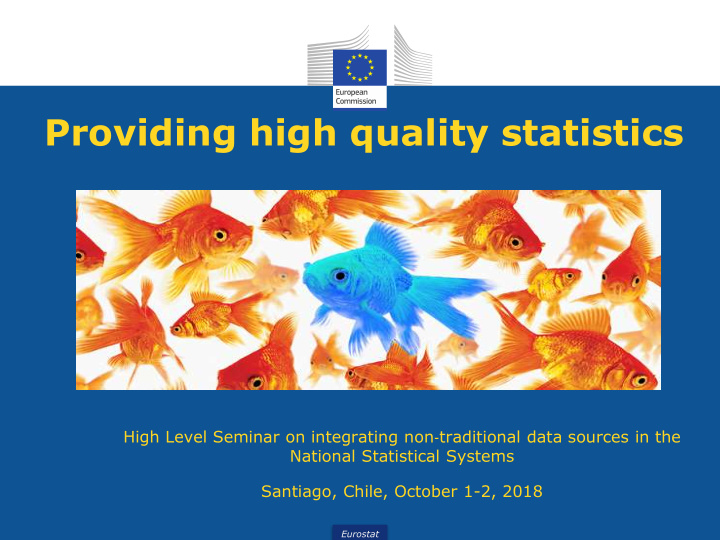



Providing high quality statistics High Level Seminar on integrating non ‐ traditional data sources in the National Statistical Systems Santiago, Chile, October 1-2, 2018 Eurostat
There is no well-established quality framework for statistics based on Big Data • Statistics based on Big Data sources is still a young field, and the adaptation (or creation of a new) quality framework needs time. • Big Data sources are so diverse, that it is hard to cover all quality aspects in one framework. • Because of the large volume of data, big data is generally processed outside the statistical office. Eurostat
Six criteria for quality in statistics • Relevance • Accuracy • Timeliness and punctuality • Accessibility and clarity • Comparability • Coherence Eurostat
Relevance • Do the statistics meet current and potential users’ needs? • Are all the needed statistics produced? • Do the concepts used (definitions, classifications, etc.) reflect user needs? • Do all statistics produced have users? Eurostat
Timeliness and punctuality Timeliness: • Is the time lag between the availability of information and the event or phenomenon it describes acceptable to users? • Do users often quote other sources, rather than the national statistical office? • Punctuality: • Is there an official data release calendar ? • Are data normally delivered on the target date? Eurostat
Accessibility and clarity Are key data published regularly and widely? • How easy is it to find and download or order the data? • Are the data accompanied by appropriate definitions • and explanations (metadata) and information on their quality (including limitations on how the data can be used)? Is there a contact point where additional assistance • can be provided by the NSI? Is data available free of charge, or is there a clear • pricing policy? Eurostat
Accuracy • Are the methods used to estimate or calculate statistics well established and adequate? • Are the primary data checked for errors? • Is the sample size satisfactory? • If administrative data or non-traditional data sources are used, are they adequate for the purpose? Eurostat
Comparability Comparability over time : Are the data for different • periods compiled in the same or similar way so that results can be properly compared over time? Between geographical areas : Can the data • compiled for different regions be compared with each other? Between domains : Are the data for different • domains compiled in such a way that results can be properly compared with each other, for example between industrial sectors, between different types of households, different modes of transport, etc. Eurostat
Coherence • Can the data be reliably combined in different ways and for various users? • It is easier to show cases of incoherence than to prove coherence Eurostat
Experience of the pilot projects Seven aspects of quality identified: • coverage • comparability over time • processing errors • process chain control • linkability • measurement errors • model errors and precision Eurostat
Quality criteria Traditional Non traditional • Relevance • coverage • Comparability • comparability over time • Accuracy • processing errors • Timeliness and punctuality • process chain control • Accessibility and • linkability clarity • measurement errors • Coherence • model errors and precision
Findings • Many causes of error were found • Data sources may change over time • Clear need for big data specific checks and correction methods • Technological changes changes in the policy of the data holder • • changes in the population composition and/or amount included. Eurostat
Conclusion • Big Data quality has some familiar aspects and some new aspects. • Diverse nature of Big Data sources makes it difficult to apply standardised quality measures for different projects. • The current quality framework needs to be extended to better cover Big Data. Eurostat
For more information • ESSnet Big Data (2018) Report describing the quality aspects of Big Data for Official Statistics • UNECE, (2013) What does "big data" mean for official statistics • UNECE (2014) A Suggested Framework for the Quality of Big Data Eurostat
Last, but not least • European Conference on Quality in Official Statistics • Three day conference, plus one day of training courses • Every two years • There is a fee for participation. • Q2018 was held in Krakow, Poland • Next Q conference will be in 2020 Eurostat
Thank you for your attention konstantinos.giannakouris@ec.europa.eu Eurostat
Recommend
More recommend